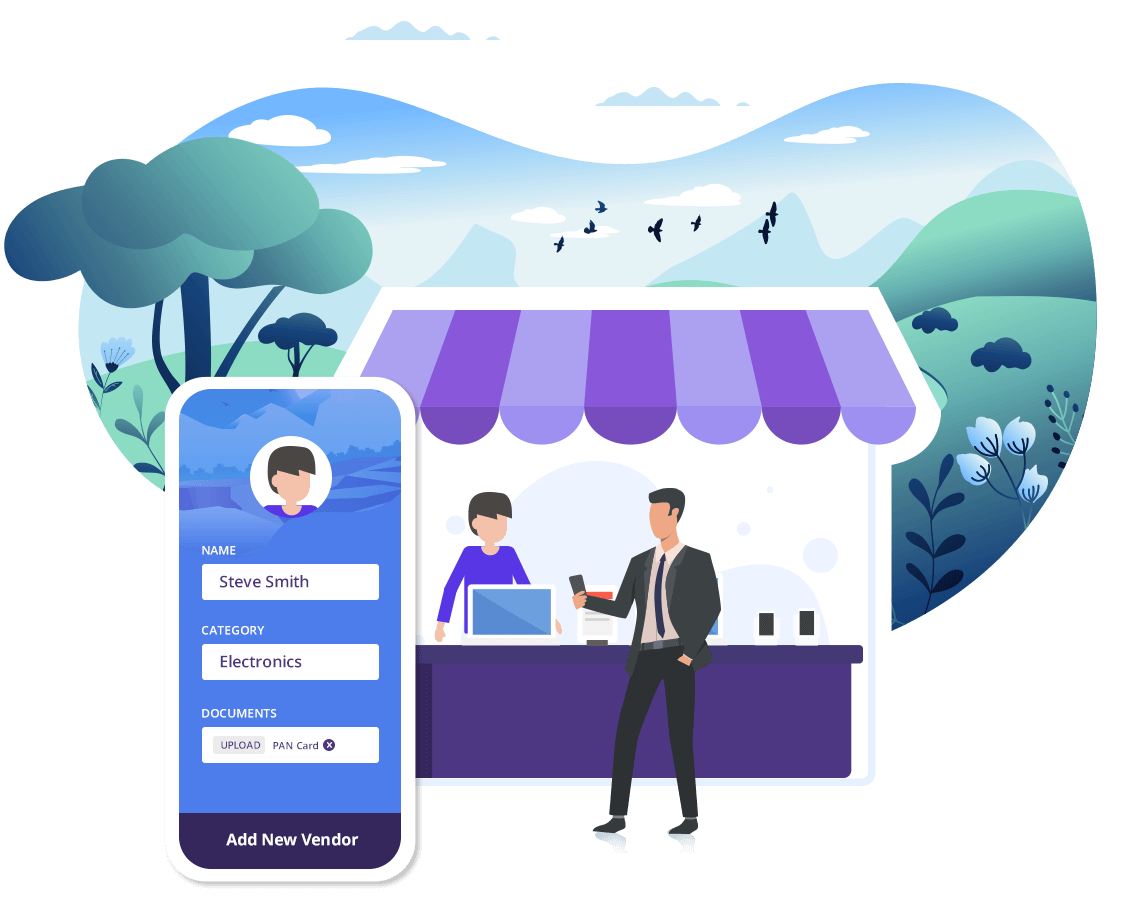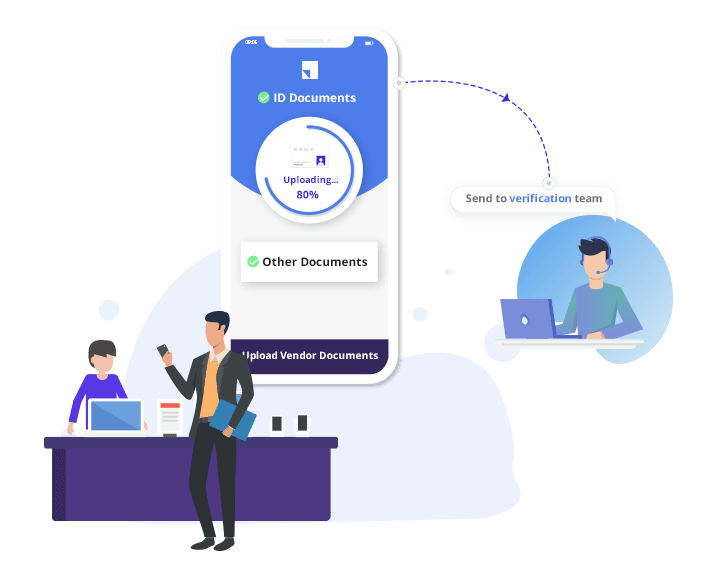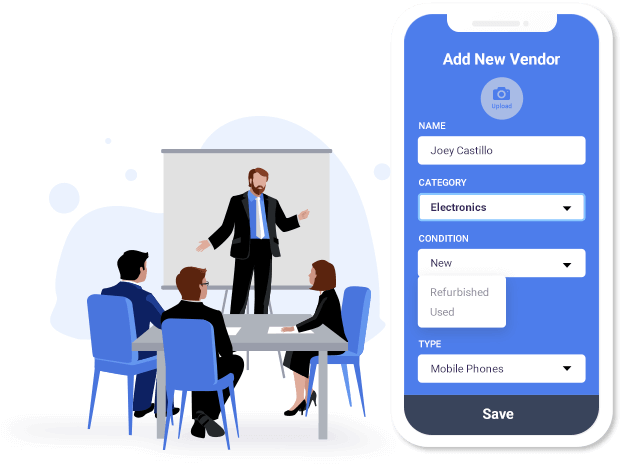Vendor Onboarding is the process of guiding new vendors into your company’s network.
Your vendors are, after all, the backbone of your business. Not only do you want to attract the right partners, but you also want them excited about partnering with you.
Your Vendor Onboarding Process is just the first step in what you hope would be a long-lasting relationship. Not only does it help you lay down your expectations from the association, but it also gives you the opportunity to understand the vendors’ motivations, and set a precedent of what is to come, and what the vendor should expect from you.
Vendor Onboarding – A Detailed Study

Simply put, Vendor Onboarding is the process of registering new vendors who want to serve the same set of customers like you. For instance:
- For E-commerce companies like Amazon, Walmart or Alibaba, retailers and manufacturers are the vendors, trying to reach out to a broader consumer base.
- Ride aggregators like Uber, Ola, Lyft or Grab want to onboard more driving partners.
- Businesses operating in fin-tech space, like Amazon Pay, Google Pay or Paytm, would want merchants of all shapes and sizes to use their services instead of their competitors.
- Food delivery companies like Swiggy, UberEats or GrubHub want the best restaurants and delivery partners to associate with them.
What’s common here?
Both parties rely on one other. For efficient operations, you need to ensure that vendors work at their best capacity and in complete harmony. (When I say vendor, I refer to the whole league of suppliers, merchants, driving partners, delivery partners, and more.)
Now, to have high-performing vendors in your company’s supply chain, you need to have a robust Vendor Onboarding process.
How to Onboard a New Vendor / Supplier – A Step-by-Step Approach
For different kinds of Vendors, the onboarding process can be entirely different. However, there are some standard steps that are always involved. Let’s look at them.
1. Understand Your Vendors

The onboarding process starts with an addition of the vendors to your database, made concrete by document collection. It helps ensure that not only you partner with professional entities, but also understand their motivations. It reinforces the understanding that your vendors would follow the norms and policies laid out by regulating authorities.
2. Verify their Documents

The next step in the process is document verification. The verification team will weigh the vendor information and documents against the company’s standards. They will decide whether the vendor can work for the company or not.
3. Convey your Requirements and Expectations

The onboarding team will explain the entire operational procedure to the vendors. They will convey the information and the company’s expectations to them. It will ensure that the vendors work by the company’s policies and give substantial results.
4. Add them to Marketplace, and introduce your software

When the verification team approves or rejects the vendor, the same information is conveyed to the onboarding team. If the vendor is approved, the onboarding team will add the vendors to the marketplace, deploy the needed software, and explain the workings to them. When there is a rejection, the onboarding team may ask for some additional documents required and solve the issue.
Transforming the Vendor Onboarding Process
Let us take an example of the most common thing out there – Telephone.
Until 1876, letters were the only medium of long-distance communication. It was the conventional way.
Then, what changed?
Alexander Graham Bell invented the Telephone. Can you visualize how technology revamped the entire horizon of long-distance communication?
The same thing has happened with the Vendor Onboarding process. Technology came into the picture and it possesses the capability to transform it completely, given it’s utilized properly.
You might be wondering, what technology?
It is the Vendor Onboarding Software.
So, let us make Vendor Onboarding hassle-free now. Shall we?
Vendor Onboarding Software – The Complete Solution
Vendor Onboarding Software provides all the necessary tools for increasing the efficiency of your onboarding team. These inputs ensure that the work is streamlined, targeted and never off the mark.
It connects your employees with their team and their managers in the most practical way!
In addition to that, there are various other benefits of the Vendor Onboarding Software.

Why is efficient vendor/supplier onboarding important?
A good vendor onboarding process helps your company develop a fortified relationship with the vendor. When you deliver the process professionally, vendors feel that they add value and are an integral part of your company.
This increases their motivation to work with you, and hence, their efficiency.
A smooth, hassle-free onboarding process would attract good vendors to associate with you, whereas a shaky, unstandardized process might put them off, and have them lose trust in you, right at the get-go.
Let me take you through a story that will cement the need for Vendor Onboarding.
The need for good vendor onboarding – A story
In college, I had an entrepreneurial bug inside me. I started trading in bulk orders of customized T-shirts. My vendors were fabric manufacturers in the biggest cotton hub of Southern India.
But, I didn’t have a standard vendor onboarding process.
And that was my undoing!
As is bound to happen sometime in every business, one of my orders got delayed. Monetary loss and damage in reputation followed. Those were some dark days.
I realized that the major cause of this catastrophe was the absence of a standardized vendor onboarding process. While onboarding my vendors, almost the entire agreement was verbal. I didn’t verify any documents, nor did I officially convey my expectations. The whole collaboration was based on implied trust, even before any kind of trust was established.
Major Challenges in Onboarding a New Vendor/Supplier
Field Agents’ Outlook:
- Without a vendor onboarding software aiding them on the field, the agents will add the positive leads to their excel sheet, or note them down manually. They would either need to carry their laptops everywhere or add the leads later to the system at the end of the day. Result = reduced efficiency.
- They will need to check the addresses of the vendors and plan their routes accordingly. This will increase the delay in their commute as they may not choose the most optimal routes, or just add to their stress in an already busy day.
- After a standard of 4-5 meetings daily, the vendor onboarding agents need to arrange the documents of every vendor and then forward it for verification. In such scenarios, sometimes the documents are mishandled, creating chaos in the verification team’s workday, or just causes a delay in a process that could have been carried out in real-time.
- Vendor onboarding consultants need to carry different documents according to the vendors and their product categories. It creates confusion and makes their work even more strenuous.
Manager’s Outlook:
- Managers mostly live in the shadows of confusion when they track their field operatives. They are not certain of their location and the time spent at a meeting.
- If there is a failure or a simple miss in the verification process, managers need to reassign the task to their field operatives, which they might forget, delaying the onboarding process.
The Solution
Vendor Onboarding Software addresses all challenges and lays open numerous opportunities for efficiency while onboarding new partners.
In your core, you always felt there was a scope of improvement.
A good Vendor Onboarding Software empathizes with you completely. It connects your team, your managers and your vendors, and provides you with an opportunity to create an exemplary onboarding process.
As the saying goes: “Grab the opportunity when it knocks”
Knock! Knock!
You can watch our webinar on vendor onboarding below:
Read Next: What is Vendor Management – an Essential Guide
FAQs
A smooth process requires planning. Here are some hurdles to anticipate:
1. Incomplete or inaccurate information: Ensure vendors provide all necessary information during onboarding, including legal documents, tax details, and product data. Incomplete information can delay the process and require back-and-forth communication.
2. Lack of clear communication: Establish clear communication channels and expectations throughout onboarding. Regularly update vendors on the progress and address any questions or concerns promptly.
3. Technical difficulties: Anticipate potential technical issues with integrating vendor systems with your marketplace platform. Have a plan for troubleshooting and provide technical support to vendors during the onboarding process.
Efficiency saves time and resources. Here are some tips:
1. Standardize the onboarding process: Develop a well-defined onboarding flow with clear steps and consistent procedures for all vendors. This ensures a smooth and predictable experience for all new partners.
2. Utilize technology: Leverage online portals, self-service tools, and automated workflows to streamline data collection, document verification, and account setup during onboarding.
3. Provide clear instructions and resources: Develop comprehensive onboarding guides, FAQs, and training materials to equip vendors with the knowledge and resources they need to navigate the onboarding process successfully.
Metrics track progress. Consider these key performance indicators (KPIs):
1. Time to complete onboarding: Track the average time it takes for vendors to complete the onboarding process. This helps identify bottlenecks and areas for improvement.
2. Vendor onboarding completion rate: Monitor the percentage of vendors who successfully complete the onboarding process. A low completion rate could indicate issues with the program’s clarity or complexity.
3. Vendor satisfaction: Gather feedback from vendors through surveys or interviews to assess their experience with the onboarding program and identify areas for improvement.









